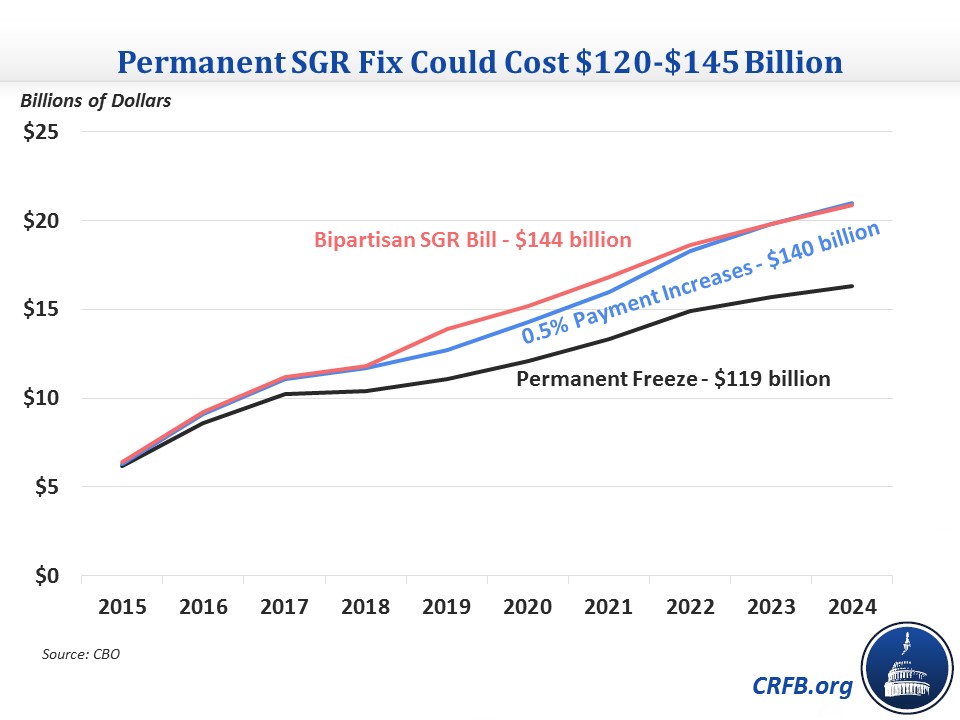New CBO Estimates Set the Stage for "Doc Fix" Discussions
Following a final rule issued by the Centers for Medicare and Medicaid Services (CMS), CBO has updated its estimate of various "doc fix" policies to replace the Sustainable Growth Rate (SGR) formula. The new estimates show mixed news for policymakers depending on the type of approach they wish to take.
CMS determined that the SGR would cut Medicare physician payments by 21.2 percent in April when the current doc fix expires. Simply freezing physician payments at today's levels would cost $119 billion over ten years, somewhat less than the $131 billion CBO estimated in its August baseline. Providing 0.5 percent annual payment increases, as Congress did for 2014, would cost $140 billion.
Importantly, CBO re-estimated the bipartisan agreement on a permanent SGR replacement at $144 billion, $6 billion more than projected in February – and that estimate included $16 billion of new spending that was passed in the doc fix this past spring, although some of the savings within the SGR replacement bill were used to help offset the temporary fix.

In addition, growing physician payments with the Medicare Economic Index (MEI), which generally grows 2 to 2.5 percent per year, would cost $204 billion.
CBO did not update its estimate of the smaller health extenders that modify certain Medicare payments and Medicaid coverage; those policies were added into a subsequent Senate bill and (along with a few other policies) projected to cost an additional $37 billion. Thus, if lawmakers are to take up a permanent physician payment bill in the lame duck, it could cost anywhere between $120 billion and $180 billion. Our PREP Plan, which proposes specific offsets for a doc fix, assumes a cost of $170 billion.
| Ten-Year Cost of Doc Fix Options | ||
| New Score | Old Score | |
| Permanent Freeze | $119 billion | $131 billion |
| Permanent 0.5% Payment Increases | $140 billion | $136 billion* |
| Permanent MEI Payment Increases | $204 billion | $225 billion* |
| Bipartisan SGR Replacement | $144 billion | $138 billion* |
| Freeze Through 2015 | $14 billion | N/A |
| 0.5% Payment Increase Through 2015 | $13 billion | N/A |
| MEI Payment Increase Through 2015 | $13 billion | N/A |
Source: CBO
*Scores are as made at the time, not accounting for subsequent doc fixes.
If policymakers do not replace the SGR before April, they could continue to enact "doc fixes" temporarily halting SGR cuts. A payment freeze through the end of 2015 would cost just under $14 billion, while going through 2016 would cost $32 billion. Interestingly, the temporary fixes show that the scheduled SGR cuts continue to shrink in size over the next few years, a reflection of the Medicare slowdown. In contrast to the history of doc fixes during the 2000s, when each delay would result in the cut growing, the SGR cut has shrunk from 27 percent in 2012 and 2013 to 24 percent in 2014 and 21 percent next year. A freeze for 2015 would set up a cut of "only" 17 percent for 2016, and a two-year freeze would cue up a cut of 14 percent in 2017. The near halving of the SGR cut is a pretty remarkable turnaround, although it is not expected to maintain this downward trend.
CBO's new estimates set the stage for what lawmakers choose to do in the lame duck. If they go for a permanent fix, they'll have a $145 or $185 billion cost to offset. Otherwise, they would break with the longstanding precedent of paying for SGR fixes and further add to an already unsustainable debt. As our PREP Plan shows, there are plenty of health care offsets available to replace the SGR and remain deficit-neutral.


